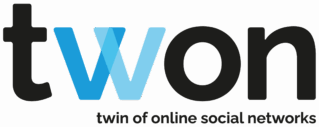What?
TWON is an EU-funded project that sets out to study the potentially harmful effects of online social networks (OSNs) on democratic debates. By creating a digital twin of an OSN and populating it using generative artificial intelligence, the TWON-team is spearheading a unique approach to studying democratic debates online that is independent from the good will of companies like Twitter, Meta, or TikTok. By analyzing different platform design and algorithmic choices, the researchers aim to better understand how people form radical political opinions online, how disinformation spreads, and how such tendencies lead to a more polarized society. Based on the findings of this project, the TWON project will produce evidence-based recommendations for regulatory innovations regarding OSNs and enhance digital citizenship by participatory methods.
Why?
A wide range of literature has addressed the question to which extend so-called filter bubbles and/or echo chambers form a problem for democratic societies, ranging from disciplines such as political and communication sciences to social physics, complexity science and computer science. Yet, they come to divergent conclusions regarding the question in how far exposure to and sharing of political information and news content can (a) be described as characterized by filter bubbles and/or echo chambers; and (b) in how far this leads to democratically undesirable outcomes such as polarization, radicalization, and the spread of misinformation. TWON addresses such discrepancies by integrating multiple methodological approaches: qualitative analysis, theory-informed simulations, and the quantitative analysis of empirical digital trace data. It develops metrics informed by democratic theory and operationalized such that they can be deployed automatically and at scale to quantify democratic consequences.
How?
The research design of TWON is multifaceted. On one hand, the development and deployment of the digital twin is crucial to the project’s success. By utilizing social network theory in crafting this twin, TWON mirrors real OSNs and populates the newly-created social network using approaches footing on generative artificial intelligence. In a second step, the digital twin will be estimated and analyzed through multifaceted real-world case studies on topics like the COVID-19 pandemic and the war in Ukraine. By covering and analyzing not only multiple topics, but multiple regions, platforms, and languages, TWON aims to provide evidence not just for one or two specific cases, but generalizable contributions to the academic discourse and, subsequently, decision-making processes of European policymakers. Finally, as researchers develop TWON, its digital twin elements as well as the case studies and policy recommendations, findings will be shared with a broader European public through innovative formats like Citizen Labs; input from citizens will be actively considered and utilized in making the model more representative and transparently available to a broad audience.
What’s this new approach?
In TWON, we create a digital twin of an OSN and populate it using generative artificial intelligence.
In our Large Scale Simulations, we analyze the effects of specific platform design and ranking algorithms on opinion dynamics and the quality of discourse by bringing together our platform modeling and our generative agents.
This approach is independent from the good will of companies like X, Meta, or TikTok.
Generative Agents
The synthetic generative agents form the virtual population in our platform simulations. Powered by generative AI, they create content or interact with it, mimicing authentic users. We calibrate them using empirical data to make them act as realistic as possible.
Case Studies
We explore the impact of platform mechanics (such as algorithmic design) on opinions, debates and dialogues of real users in Serbia about the war in Ukraine and in Germany about health topics.
Debate Quality Metrics
To study the effect of platform design, we developed a metric to measure debate quality. Key indicators are: (1) Exposure to political content, (2) Engagement with political content, (3) Contributing political content, (4) Diversity of exposure, (5) Quality of exposure.
Network Modeling
OSNs are logical models. For building the TWON, we model the network mechanics, but also the user behavior: What posts do users see? Which behavior is rewarded and how? When do users choose to write, like, or comment a post?
Who we reach?
Our work focuses on outreach and impact creation. Our goal is to get our results to the right people and to shape a democratic society. To this end, we develop policy recommendations for decision-makers and platform providers.
Citizen Labs
With our partner DialoguePerspectives e.V., we host multiple Citizen Labs, where we discuss our results and the implications for the real world. With this format, we obtain feedback, foster digital citizenship and build bridges between academia and society.
